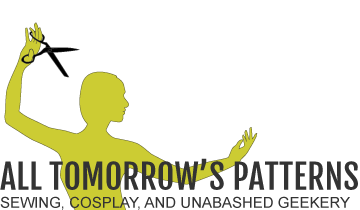
I didn’t expect to get into another competitive sport after I quit gymnastics, but I’ve found myself getting hooked on cosplay contests. I’m not the winning-motivated kind of competitive, but I’m definitely the kind where if you lay down a challenge I’ll go to excruciating lengths to meet it, and the challenge of creating a competition-worthy costume hits me right in the obsessive tendencies. The competitive community is also a really fantastic concentration of interesting and innovative creators, and there’s nothing I like better than talking shop with other overambitious craft nerds.
If you’ve competed in cosplay lately, or even just watched a competition or two, you’ve probably encountered some kind of attempt to divide cosplay up into categories. Needlework and armor are typical, sometimes bolstered by a larger-than-life, fx, or catch-all group that accounts for specialized techniques like wing building, body paint and prosthetics, or lighting and electronics. The reason for grouping entries this way is straightforward: cosplay is a multi-faceted hobby drawing on a wide range of skillsets, and to judge a giant foam robot against a hand-sewn historical gown isn’t so much apples to oranges as elephants to race cars. Categories make it easier to compare like to like, so that both judges and audience can more easily see how the entries stack up. They also present a way of organizing the contest, with natural breaks that help to keep the show feeling fresh.
But in practice, choosing what category your costume fits into can cause a lot of angst. Where do you enter the half-and-half design so common in fantasy and game designs, which pairs an ornately embroidered robe or skirt with a breastplate, pauldrons, and light-up wizard staff? Even my Ciri costume challenges categorization. To most people it probably reads as an armor build. But if you compare the time I spent on the various components, it probably has less than 200 hours of work on the ‘hard’ chainmail and worbla pieces and 400+ hours on hand embroidery, boots, and miscellaneous sewing and leatherwork. On the other hand, my pal Cornetto Cosplay is working on Nyx from Hades, a character who wears a loosely draped gown with elaborate jewelry and over-the-top hairstyle. The costume is mostly fabric, so it looks like a needlework build, but in fact the sewing part is relatively simple while a huge amount of work goes into the 3d-printed jewelry – a technique more typical of armor.
It’s actually more common than not for a costume to pull elements from more than one skill domain, so how do you choose which category to enter? Do you pick the largest fraction of the costume, down to counting components or surface area? Do you pick the area that displays the most technical skill? Some contests will even move people between categories, because the organizers or judges disagree about which is the best fit or simply to balance out numbers, which is a recipe for confusion and disappointment if they don’t have all the information about what went into the build.
If the goal is to avoid turtle-to-piano comparisons and ensure everyone is being assessed against comparable skillsets, then this premise also runs into trouble within the categories. Leatherwork is often lumped in with the sewing category, which is sensible on the textile-meets-thread face of it but can result in weird misjudgments because they draw on very different craft traditions. A maker of historical gowns does not necessarily know what goes into wet molding, stamping, and carving leather, and an adept leatherworker can still be baffled by corsetry or padstitching. Within armor you have foam, thermoplastics, moldmaking and casting, and 3d printing, which are all wildly different processes with their own challenges and techniques to master. That’s not even getting into such classic genre-defiers as animatronic wings and creature makeup, which are often lumped into the same third category despite having even less in common than sewing and foam.
A distinction that I don’t often see addressed in contest categories is between manual and digital fabrication. How do you weigh the relative quality of hand embroidery versus machine embroidery? How do you assess a worbla component or one hand sculpted in clay and then cast versus a 3d-printed one? On the one side, you have difficult manual skills that can take years to develop through exhaustive practice. On the other, you can more readily replicate the crisp surface and perfect symmetry of a manufactured item, and the speed bonus can allow for additional detail in the overall build. Flame wars I’m sure have raged over which method is technically superior or more difficult, but of course the answer is neither. They’re just different, and a fair judging system has to weigh each independently on its own merits. Making this clear in the categories instead of leaving it implicit or at the discretion of the judges might be one way forward.
But on another level, I think this whole category business might be a lost cause, and the reason is the best in show award. Nearly every contest has one, and by collapsing all the categories into one podium of overall winners it demonstrates that in the end you’re going to compare pineapples and starfish after all. So how can we acknowledge this while still promoting fair and meaningful competition? I think it starts by accepting that cosplay is an inherently interdisciplinary craft, encompassing many different skillsets. Each competitor brings some subset of these skills to the table, and each judge is competent to assess some other subset, and hopefully by spelling out the variety of techniques on offer you can present a diverse and interesting pool of costumes to a group of people who know what exactly they’re looking at, without forcing people to pigeonhole themselves.
Competitive gymnastics also has the problem of how to objectively compare routines that don’t necessarily contain the same skills. It deals with this through the Code of Points, which is a comprehensive listing of all the documented skills grouped by apparatus, type of movement, and difficulty rating. So instead of requiring every routine to be the same, they can establish guidelines for the number of jumps, turns, and flips and assign points for difficulty and quality of execution. Although still sometimes subjective and subject to infuriating politics, the Code allows routines to be customized for each athlete’s skills, preferences, and creativity to a much greater extent than would otherwise be possible while allowing meaningful competition between them.
This doesn’t translate directly to cosplay contests because we’re a collection of hobbyist nerds with no governing body to establish such a code or train judges to interpret it. Cosplay contests are hosted by a hodgepodge of volunteer and commercial conventions with no incentive to coordinate on such a level, and the entire enterprise is too niche and too low-budget to justify this amount of organization. But I think that anybody putting together a rubric for contest scoring could take inspiration from the general approach, and maybe we can move toward a structure that reflects the multifaceted reality of cosplay.
Imagine if a contest entry form presented a list of categories, and instead of shoehorning you into one it asked you to pick the three areas that you’d like to be judged on. So maybe the contest is looking at sewing, armor, electronics, makeup/prosthetics/wig work, and engineering. You’ve got the classic light-up giant robot, so you check armor, electronics, and engineering for the rigging and stilts. Next to you is a cosplayer in an embroidered ballgown, who checks engineering for the hoopskirts but also sewing and wig work for their towering 18th century coiffure. The judges have a score card that tallies points for each category, based on the difficulty and execution of the techniques, and every category is worth the same number of points overall. So you’re rewarded for a diverse skillset, but because you can pick and choose the areas where you’ve made the best showing, you don’t necessarily have to be good at everything or incorporate more techniques than the particular build calls for.
I’m not a contest organizer and event planning is the opposite of my cup of tea, so I’m flinging this out into the universe as a challenge and hoping that the community will pick it up and run with it. If none of us know how to categorize our costumes, then maybe it’s the structure that’s the problem. What can we build that will be clearer, fairer, and more attuned to the needs of the community than what we’ve seen so far?
